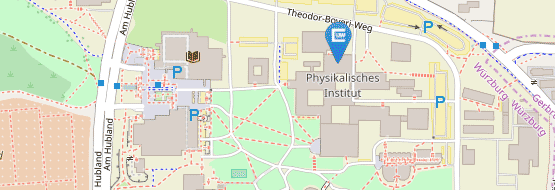Temperature effects, correlation and dynamical aspects in angle-resolved photoemission spectroscopy
01/14/2016Jürgen Braun, Department Chemie, Ludwig-Maximilians-Universität München SFB Colloqium in SE2 at 16:15
A brief introduction to the theory of angle-resolved photoemission spectroscopy (ARPES) of solids is given with an emphasis on the so-called one-step-model of photoemission that describes excitation, transport to the surface and the escape to the vacuum in a coherent way. This is followed by a short description concerning new features in the spin density matrix implementation of the one-step-model within the Munich SPR-KKR program package [1,2].
This method allows a fully relativistic computation of photoemission spectra from solid materials for photon energies ranging from 10 eV up to 10 keV. To take account for electronic correlations beyond the local spin density approximation (LSDA) a combined LSDA +DMFT scheme for self-consistent electronic structure calculations has been employed [3]. Temperature effects are considered within an alloy analogy model [4] that goes well beyond the simple, but standard Debye-Waller approach to
photoemission by including in particular the temperature dependence of the effective photoemission matrix elements as well. This allows among others to reproduce the so called XPS- or density of states limit in angle-resolved photoemission which occurs for high photon energies and/or high temperatures due to a full Brillouin zone averaging caused by phonon scattering [5]. To illustrate the applicability of the new formalism examples of ARPES and x-ray photoemission calculations on simple metals as well
as on complex compounds like topological insulator systems will be presented.
As the latest development a theoretical frame for the description of pump-probe photoemission is presented. The approach is based on a general formulation using the Keldysh formalism for the lesser Green function to describe the real-time evolution of the electronic degrees of freedom in the initial state after a strong pump pulse that drives the system out of equilibrium. The final state is represented by a time-reversed low-energy electron diffraction (LEED) state. The formalism allows for a quantitative calculation of the time-dependent photocurrent in particular for simple metals where a picture of effectively independent electrons is assumed as reliable [6]. As a first application, the theoretical description of two-photon photoemission (2PPE) for real systems within the SPR-KKRapproach is introduced.
[1] J. Braun, K. Miyamoto, T. Okuda, M. Donath, A. Kimura, H. Ebert, and J. Minar, Topological behavior of d-like surface resonances: the one-step model in its density matrix formulation applied to W(110), New Journal of Physics 16, 015005 (2014)
[2] H. Ebert et al., The Munich SPR-KKR package, version 6.3, http://olymp.cup.uni-muenchen.de/ak/ebert/SPRKKR (2012)
[3] J. Minar, L. Chioncel, A. Perlow, H. Ebert, M. I. Katsnelson, and A. I. Lichtenstein, Phys. Rev. B 72, 045125 (2005)
[4] J. Braun, J. Minar, F. Matthes, C. M. Schneider, and H. Ebert, The theory of photoemission for correlated magnetic alloys: a LSDA+DMFT study on the electronic structure of NixPd1-x, Phys. Rev. B 82, 024411 (2010)
[5] J. Braun, J. Minar, N. B. Brookes, S. Mankovsky, L. Plucinski, C. M. Schneider, C. S. Fadley, and H. Ebert, Exploring the XPS-limit in hard x-ray angle-resolved photoemission spectroscopy by fully temperature-dependent one-step theory, Phys.
Rev. B. 88, 205409 (2013)
[6] J. Braun, R. Rausch, M. Potthoff, J. Minar, and H. Ebert, Pump-probe theory of angle-resolved photoemission, Phys. Rev. B 91, 035119 (2015)


